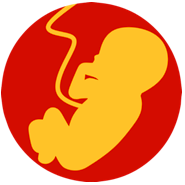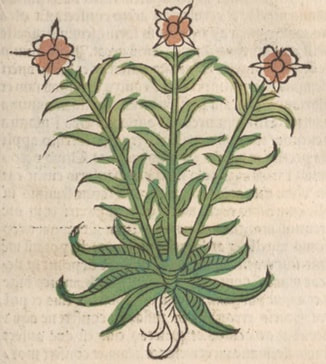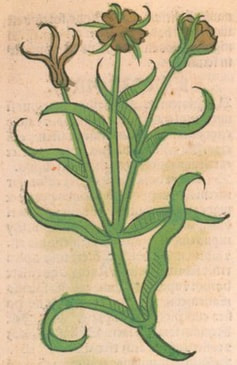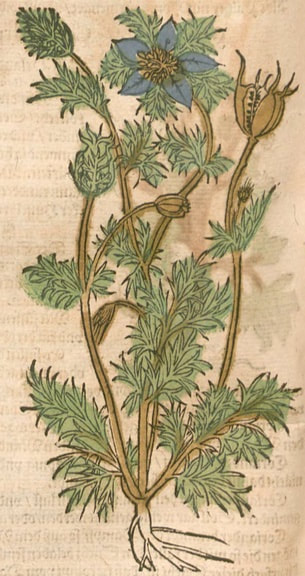Krauterbuch, Lonitzer, 1578
Botanical name:
Nigella spp.
Parts used:
Seed
Temperature & Taste:
Warm, dry, Pungent
Classifications:
2H. CARMINATIVE. 2K. RESOLVENT
3F. LITHONTRIPTIC. 3H. LACTAGOGUE. 3P. MASTICATORIES & STERNUTATORIES 3Q. ANTHELMINTIC
Nigella spp.
- N. sativa
- N. damascena
- N. glandulifera (syn. Nigella sativa var. hispidula)
Parts used:
Seed
Temperature & Taste:
Warm, dry, Pungent
Classifications:
2H. CARMINATIVE. 2K. RESOLVENT
3F. LITHONTRIPTIC. 3H. LACTAGOGUE. 3P. MASTICATORIES & STERNUTATORIES 3Q. ANTHELMINTIC
Uses:
1. Warms the Stomach, Moves Qi:
-cold and weak Stomach, Indigestion
2. Warms Kidneys, Clears Damp, Promote Urine:
-Edema, Fluid retention
3. Warms the Lungs, Clears Phlegm:
-Cough, Bronchitis
4. Moves Qi, Promotes Menstruation:
-Amenorrhea
5. Promotes Milk
6. Settles Wind, Clears Cold:
-Headache, Migraine
7. Resists Poison:
-venomous Bites
8. Kills Worms:
9. Externally:
-Headache (plaster topically, Dioscorides)
Dose:
Powder: 1–3 grams
Decoction: 3–9 grams
Corrective:
... available in PRO version
Substitute:
... available in PRO version
Comment:
... available in PRO version
Powder: 1–3 grams
Decoction: 3–9 grams
Corrective:
... available in PRO version
Substitute:
... available in PRO version
Comment:
... available in PRO version
Main Combinations:
1. Colic, gastrointestinal spasm and pain:
i. Nigella with ... available in PRO version
ii. Nigella, ... available in PRO version
2. Indigestion from Cold:
i. Nigella, ... available in PRO version
ii. Nigella, ... available in PRO version
iii. Nigella, ... available in PRO version
iv. Nigella, ... available in PRO version
3. Obesity, Nigella with ... available in PRO version
4. Diarrhea from Cold and Damp:
i. Nigella, ... available in PRO version
ii. Nigella ... available in PRO version
5. Cough with thick phlegm, Nigella with ... available in PRO version
6. Edema from Cold and Damp:
i. Nigella with ... available in PRO version
ii. Nigella, ... available in PRO version
7. Strangury, Dysuria, Nigella seed, ... available in PRO version
8. To promote Menstruation:
i. Nigella with ... available in PRO version
ii. Nigella seed with ... available in PRO version
9. Uterine pain from Blood stagnation, Nigella with ... available in PRO version
10. To promote Labor:
i. Nigella with ... available in PRO version
ii. Nigella, Cinnamon, Saffron
11. Promote Breast Milk, Nigella with ... available in PRO version
12. To benefit the Brain and Memory:
i. Nigella with ... available in PRO version
ii. Nigella with ... available in PRO version
13. Worms:
i. plaster Nigella ... available in PRO version
ii. Plaster of Nigella ... available in PRO version
iii. Nigella with ... available in PRO version
14. Toothache:
i. Nigella, ... available in PRO version
ii. decoct Nigella with ... available in PRO version
15. Scabies, Itchiness, Nigella with ... available in PRO version
16. Boils and Pimples, ... available in PRO version
Major Fomulas:
Powder to Promote Birth (Alexander)
Powder to Strengthen the Memory
Troches for Hardness of the Liver
Syrup of Mugwort (Augustana)
Syrup of Mugwort Lesser (Bononiense)
Electuary of Bayberries (Electuarium de Baccis Lauri)
Electuary Against Worms
Catechu 25 (Seng ldeng 25) (Tibetan Medicine)
Pearl 25 (Mu tig nyer lnga) (Tibetan Medicine)
Wish-fulfilling Jewel (Bsam phel nor bu) (Tibetan Medicine)
Cautions:
1. Not used in medicinal doses during Pregnancy
2. Not used in Fever
Main Preparations used:
Seeds prepared (steeped overnight in Vinegar), Distilled Water and Distilled Oil of the Seeds
1. Not used in medicinal doses during Pregnancy
2. Not used in Fever
Main Preparations used:
Seeds prepared (steeped overnight in Vinegar), Distilled Water and Distilled Oil of the Seeds
Click the Tabs above for more information on this Medicine
|
'According to Birdwood, it is the Black Cummin of the Bible, the Melanthion of Hippocrates and Dioscorides, and the Gith of Pliny. Ainslie mentions its use as a carminative, also as an external application mixed with sesamum oil in skin eruptions; as a seasoning for food, and as a protection for linen against insects. Forskahl, in his Medicina Kaharina, says that it is a native of Egypt, where it is called Hab-es Souda. Roxburgh believes it to be a native of Hindostan. Anyhow, it must have been long known in India, as it has a Sanskrit name, Krishna jiraka. It is said to be cultivated in some parts of Gnzerat; but I have been unable to substantiate this statement. Nigella seed is extensively used as a spice and as a medicine. The Hakeems describe it as heating, attenuant, suppurative, detergent and diuretic, and consider that it increases the menstrual flow and the secretion of
|
milk; also that it stimulates uterine action. They give it, too, as a stimulant in a variety of disorders which are ascribed to cold humors, and credit it with anthelmintic properties, It is sprinkled over the surface of the bread made by Mahometan bakers along with Sesamum seed. M. Canolle has recently published the results of clinical investigations undertaken in the hospital at Karikol with black cummin seed. He has observed that after doses of 10 to 40 grams of the powdered seed the temperature of the body is raised, the pulse accelerated, and all the secretions stimulated, especially those of the kidneys and skin; in doses of 10 to 20 grams they possess a well marked emmenagogue action in dysmenorrhcea. (Journal de Medecine, 1883). (Vegetable Materia Medica of Western India, Dymock, 1885)
|






